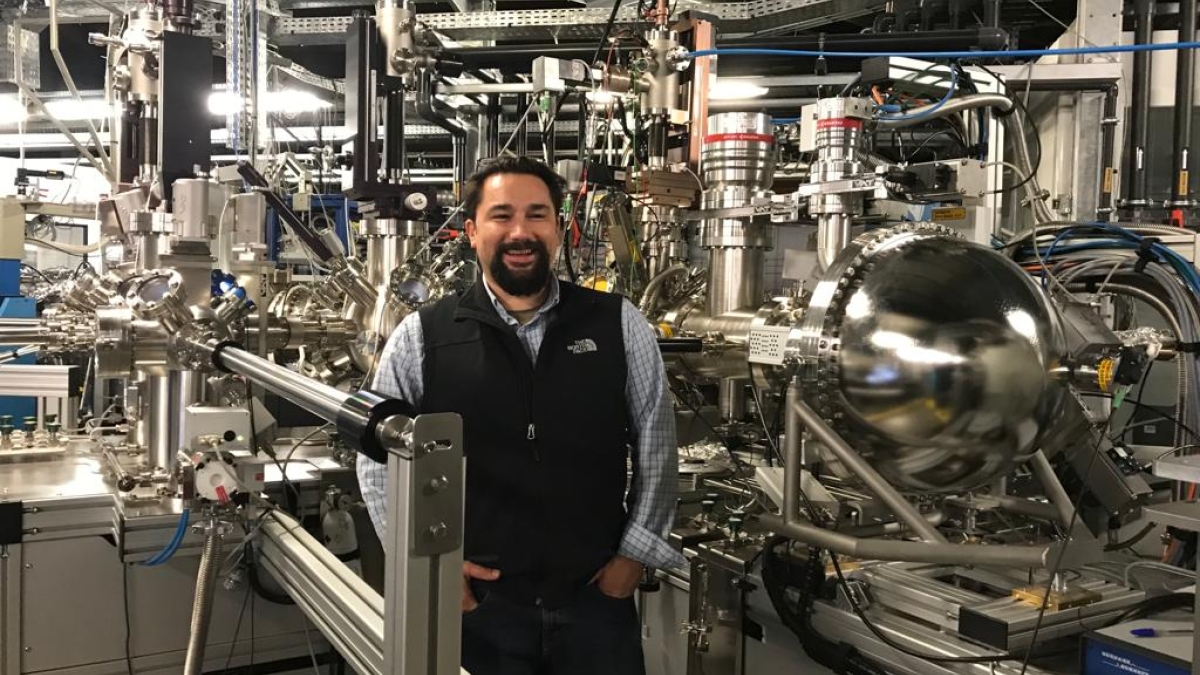ASU School of Molecular Sciences professor wins photochemistry award

ASU’s Gary Moore, an associate professor in the School of Molecular Sciences and a researcher in the Biodesign Center for Applied Structural Discovery and Center for Negative Carbon Emissions.
Gary Moore is passionate about research that has the potential to create a more sustainable, less destructive energy future.
An associate professor in Arizona State University’s School of Molecular Sciences and a researcher in the Biodesign Center for Applied Structural Discovery and Center for Negative Carbon Emissions, Moore studies what plants can teach us about solar energy storage, something he and his research team recently explored in depth in a Chemical Reviews articleAuthors include current School of Molecular Sciences graduate students Edgar Reyes Cruz, Daiki Nishiori, Nghi Nguyen and Lillian Hensliegh. titled “Molecular-Modified Photocathodes for Applications in Artificial Photosynthesis and Solar-to-Fuel Technologies.”
“Do we want to choose to make investments in research directions, technologies and policies that minimize the impact of climate change, or do we continue making use of an energy infrastructure with components and processes that are over a hundred years old?” asked Moore.
In recognition of his work and accomplishments, Moore was recently awarded the 2023 Inter-American Photochemical Society (I-APS) Young Investigator Award, which will be presented at the 2023 annual meeting at Sandestin Beach, Florida.
I-APS was established in 1975 and today has more than 600 members in academia, industry and government throughout North and South America. Its mission is “to promote and disseminate knowledge, and encourage development, of photochemistry and allied subjects throughout the Americas.”
The I-APS Young Investigator Award was established in 2002 to recognize outstanding photo-scientific contributions by society members.
“I am honored to receive this recognition from the Inter-American Photochemical Society and remain thankful for the interactions I have had with members of this community. I also acknowledge the contribution students in my research group have made toward advancing our discoveries in the photochemical and molecular sciences,” Moore said.
Ian Gould, a School of Molecular Sciences President’s Professor and associate dean of online and digital initiatives in the College of Liberal Arts and Sciences, called Moore a leader and “a force in the field of photocatalysis for real-world applications.”
“He is building hybrid, multifunctional nanoscale materials that combine multiple functions in most imaginative ways,” Gould said of Moore. “He is extending the boundaries in several scientific areas critical to advancing technology, including interfacial chemistry, energy conversion chemistry and the catalysis of industrially important fuels and basic materials for energy and manufacturing.”
Harnessing the power of sunlight
A photon is a tiny particle of light that carries energy. The amount of energy depends on whether it possesses, for example, ultraviolet, visible or infrared frequencies. Photochemistry involves the chemical effects of light, where reactions are usually caused by absorption of ultraviolet, visible light or infrared radiation.
The photons Moore’s research team works with come from sunlight and are used to convert water and air into domestically produced, non-fossil-based fuels.
“Inspired by the process of photosynthesis, we can develop alternative energy sources and industrial processes to produce clean fuels as well as other commodity products,” Moore said.
In addition to studying solar energy conversion pathways, the design and synthesis of catalysts is also central to the research efforts of Moore and his team.
Catalysts provide low-energy pathways for carrying out a chemical transformation at a desired rate. For this reason, they are used in myriad industrial applications and are imperative to the bioenergetics of all living organisms.
Moore and his group place a strong emphasis on developing effective methods for interfacing catalytic materials with those that harness solar energy. They also seek to better understand the relationships between the structure and function properties of the resulting architectures. Moore’s research provides graduate students and young professionals a wealth of opportunities.
“We are an interdisciplinary group of researchers developing molecular-based materials that are fundamentally interesting and address societal challenges,” Moore said of his research group.
Moore has earned national recognition as an emerging leader in the field of energy materials science. He is a Department of Energy Early Career Awardee, a Camille Dreyfus Teacher-Scholar, a National Science Foundation CAREER Awardee and was recognized as an “outstanding chemist with Native American heritage” by the National Science Foundation during the 2020 Celebration of Native American Heritage Month.
Moore was also selected to give emerging junior faculty research talks at the 2018 Electron Donor-Acceptor Interactions Gordon Research Conference, the 2017 Photochemistry Gordon Research Conference, and the second International Solar Fuels Conference. More recently, Moore co-organized the 2021 Western Photosynthesis Conference and the 2020 Inter-American Photochemical Society (I-APS) Conference.
More Science and technology

Breakthrough copper alloy achieves unprecedented high-temperature performance
A team of researchers from Arizona State University, the U.S. Army Research Laboratory, Lehigh University and Louisiana State…

4 ASU researchers named senior members of the National Academy of Inventors
The National Academy of Inventors recently named four Arizona State University researchers as senior members to the prestigious…

Transforming Arizona’s highways for a smoother drive
Imagine you’re driving down a smooth stretch of road. Your tires have firm traction. There are no potholes you need to swerve to…

